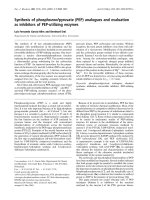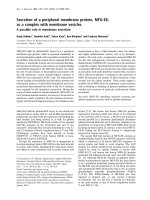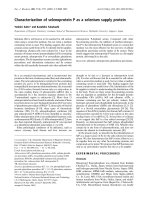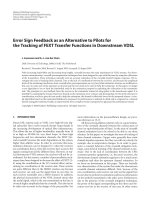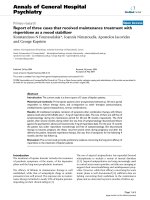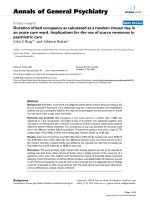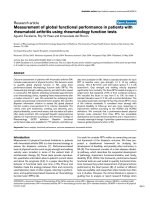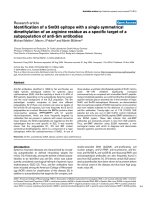Báo cáo y học: "Cost-effectiveness of micafungin as an alternative to fluconazole empiric treatment of suspected ICU-acquired candidemia among patients with sepsis: a model simulatio" ppsx
Bạn đang xem bản rút gọn của tài liệu. Xem và tải ngay bản đầy đủ của tài liệu tại đây (389.67 KB, 11 trang )
Open Access
Available online />Page 1 of 11
(page number not for citation purposes)
Vol 13 No 3
Research
Cost-effectiveness of micafungin as an alternative to fluconazole
empiric treatment of suspected ICU-acquired candidemia among
patients with sepsis: a model simulation
Marya D Zilberberg
1,2
, Smita Kothari
3
and Andrew F Shorr
4
1
School of Public Health and Health Sciences, University of Massachusetts, Arnold House, 715 North Pleasant Street, Amherst, MA 01003, USA
2
EviMed Research Group, LLC, PO Box 303, Goshen, MA 01032, USA
3
Health Economics and Outcomes Research, Astellas Pharma US, Inc., 3 Parkway North, Deerfield, IL 60015, USA
4
Division of Pulmonary and Critical Care, Washington Hospital Center, 100 Irving Street NW, Washington, DC 20010, USA
Corresponding author: Marya D Zilberberg,
Received: 5 Mar 2009 Revisions requested: 17 Apr 2009 Revisions received: 5 Jun 2009 Accepted: 19 Jun 2009 Published: 19 Jun 2009
Critical Care 2009, 13:R94 (doi:10.1186/cc7924)
This article is online at: />© 2009 Zilberberg et al.; licensee BioMed Central Ltd.
This is an open access article distributed under the terms of the Creative Commons Attribution License ( />),
which permits unrestricted use, distribution, and reproduction in any medium, provided the original work is properly cited.
Abstract
Introduction Recent epidemiologic literature indicates that
candidal species resistant to azoles are becoming more
prevalent in the face of increasing incidence of hospitalizations
with candidemia. Echinocandins, a new class of antifungal
agents, are effective against resistant candidal species. As
delaying appropriate antifungal coverage leads to increased
mortality, we evaluated the cost-effectiveness of 100 mg daily
empiric micafungin (MIC) vs. 400 mg daily fluconazole (FLU) for
suspected intensive care unit-acquired candidemia (ICU-AC)
among septic patients.
Methods We designed a decision model with inputs from the
literature in a hypothetical 1000-patient cohort with suspected
ICU-AC treated empirically with either MIC or FLU or no
treatment accompanied by a watchful waiting strategy. We
examined the differences in the number of survivors, acquisition
costs of antifungals, and lifetime costs among survivors in the
cohort under each scenario, and calculated cost per quality
adjusted life year (QALY). We conducted Monte Carlo
simulations and sensitivity analyses to determine the stability of
our estimates.
Results In the base case analysis, assuming ICU-AC
attributable mortality of 0.40 and a 52% relative risk reduction in
mortality with appropriate timely therapy, compared with FLU
(total deaths 31), treatment with MIC (total deaths 27) would
result in four fewer deaths at an incremental cost/death averted
of $61,446. Similarly, in reference case, incremental cost-
effectiveness of MIC over FLU was $34,734 (95% confidence
interval $26,312 to $49,209) per QALY. The estimates were
most sensitive to the QALY adjustment factor and the risk of
candidemia among septic patients.
Conclusions Given the increasing likelihood of azole resistance
among candidal isolates, empiric treatment of ICU-AC with 100
mg daily MIC is a cost-effective alternative to FLU.
Introduction
Emerging antimicrobial resistance poses a significant threat to
health care in the USA and abroad. Pathogens such as methi-
cillin-resistant Staphylococcus aureus, extended-spectrum
beta-lactamase Gram-negative organisms, Clostridium diffi-
cile and Pseudomonas aeruginosa are increasingly encoun-
tered and now exhibit resistance to some traditional therapies.
This same trend has been observed with fungal infections.
First, there has been a shift in the distribution of species
responsible for candidal bloodstream infections (BSIs). Multi-
ple analyses document that one-third to one-half of all candidal
BSIs are due to non-albicans species [1-5]. Second, and more
importantly, Candida glabrata (CG) and Candida krusei (CK)
now account for as many as 20 to 25% of all candidal BSIs [6-
9]. These two specific pathogens are generally not suscepti-
ble to fluconazole, a drug commonly used in critically ill
patients.
BSI: bloodstream infections; CA: Candida albicans; CG: Candida glabrata; CI: confidence interval; CK: Candida krusei; C&S: culture and sensitivity;
FLU: fluconazole; ICU: intensive care unit; ICU-AC: ICU-acquired candidemia; MIC: micafungin; QALY: quality-adjusted life year.
Critical Care Vol 13 No 3 Zilberberg et al.
Page 2 of 11
(page number not for citation purposes)
Accompanying these microbiologic and epidemiologic shifts,
the burden of candidal BSIs is rising. The past six years has
witnessed a 50% growth in hospitalizations complicated by
candidal BSIs [10]. This trend has also been seen in critically
ill patients [11]. Unfortunately, many clinicians do not consider
fungi as a cause of severe sepsis and BSIs. This is of particular
concern given that either a delay in initiation of antifungal ther-
apy or treatment with an antifungal that is not active against
the specific fungal pathogen independently raises a patient's
risk of death [12,13].
To address the need to provide initially appropriate antibacte-
rial therapy, many advocate a strategy based on de-escalation.
In this paradigm, one begins treatment with multiple agents or
agents with broader coverage profiles based on local suscep-
tibility data and then adjusts and/or discontinues anti-infec-
tives as culture and sensitivity (C&S) results return. One
concern about a de-escalation approach to potential fungal
BSIs is that echinocandins, which represent a commonly used
class of broad-spectrum antifungal agents used in the inten-
sive care unit (ICU), are expensive relative to the burden of
Candida. In essence the issue becomes, in part, that of the
cost and benefit balance.
Therefore, because ICU patients with hospital-acquired sepsis
represent a group at high risk for the development of ICU-
acquired candidemia (ICU-AC) [14-17], and given the increas-
ing frequency of resistant candidal species coupled with the
clinical importance of broad empiric coverage, we hypothe-
sized that empiric utilization of the newly-approved dosage of
100 mg daily of micafungin (MIC) [18], an echinocandin,
would be a cost-effective strategy when compared with either
empiric fluconazole (FLU) treatment or to a strategy of watch-
ful waiting pending C&S results. To test this hypothesis we
developed a decision model to quantify cost and outcome dif-
ferences between these various options.
Materials and methods
No human subjects were enrolled in the study, and, thus, the
study was exempt from regulations guiding protection of
human subjects. This is an analysis of publicly available data.
All calculations were performed in Microsoft Excel 2003
(Microsoft, Redmond, WA, USA). Multivariate simulations and
sensitivity analyses were performed using Crystal Ball soft-
ware (Decisioneering, Denver, CO, USA).
Model overview and structure
We developed a cost-effectiveness model comparing MIC
with FLU and MIC or FLU with watchful waiting as the empiric
treatment for suspected ICU-AC. We performed our analyses
from the perspectives of both the hospital and population in
general. We followed the recommendations of the Panel on
Cost-Effectiveness in Health and Medicine [19]. We utilized a
decision-analysis approach with a single decision node repre-
senting the choice to institute treatment with MIC or FLU, or to
withhold treatment until culture confirmation. We conducted
an analysis in a hypothetical cohort of 1000 patients in the
ICU. We marched this cohort through each branch of the deci-
sion tree separately to either death or illness resolution and
calculated the incremental costs associated with each choice
(Figure 1). The parameters for the incidence of candidemia
overall and the likelihood of infection with resistant species
(CG or CK), and the various clinical and economic conse-
quences were derived from a review of pertinent literature and
other publicly available data (Table 1). We examined the differ-
ences in hospital mortality, drug acquisition costs, and total
lifetime health care costs in the cohort under each scenario.
Because our literature review failed to identify any studies
quantifying the incremental utilization and economic outcomes
associated with inappropriate empiric treatment of candi-
demia, and to avoid introducing additional uncertainty into the
model by using unsupported estimates, we were unable to
include this component of health care costs into our calcula-
tions. However, given the recent report that direct variable
hospital costs are minimally impacted by reducing ICU or hos-
pital length of stay, the current inputs are likely to be of great-
est relevance [20]. Therefore, we defined cost-effectiveness
from the hospital perspective as the ratio between drug acqui-
sition cost differences and the differences in the numbers of
hospital deaths between the strategies. In turn, the reference
case built from the societal perspective examined lifetime
health care costs of survivors per quality-adjusted life year
(QALY) as the unit of cost-effectiveness of each strategy.
Because of the uncertainty surrounding the point estimates for
various model inputs, we conducted several Monte Carlo sim-
ulations and sensitivity analyses to assess the precision and
stability of these observations. The 95% confidence intervals
(CIs) around the point estimates were calculated based on the
Monte Carlo simulations. One-way sensitivity analyses were
performed to establish cost-effectiveness threshold values
and the worst-case scenario. Two-way sensitivity analyses
were conducted to establish the ranges in the outcome esti-
mate introduced by two of the inputs contributing most to the
uncertainty in the model.
Model inputs
Incidence of ICU-acquired candidemia
For the proportion of patients in the ICU developing candi-
demia, we derived numbers from several large international
cohort studies. Although we initially set out to build a model
specifically relevant to the USA, our search did not identify any
generalizable studies in this area. Looking to the studies out-
side the USA, four reported in various ways the prevalence of
ICU-AC as it applies to the ICU population of patients with
sepsis [14-17]. The four studies all represent recent epidemi-
ologic cohorts in sepsis populations [see table S1 in addi-
tional data file 1]. Based on these four studies, we used the
mean prevalence of candidal culture positivity as the point esti-
Available online />Page 3 of 11
(page number not for citation purposes)
mate and the range as the uncertainty range around the point
estimate.
Incidence of resistant candidal species
We examined the literature from the US institutions published
in the current decade pertaining to the setting of the adult ICU.
Based on the six studies so identified [4,6-9,21] [see table S2
Additional data file 1], we calculated the pooled prevalence of
CK and CG as a function of all positive candidal blood cultures
and used this number as the point estimate, and the range of
prevalences from the six studies as the range around the point
estimate. Despite the fact that not all CG and CK isolates are
azole resistant, we essentially used CG/CK as a surrogate for
azole resistance for two reasons. One practical consideration
for this choice was driven by non-availability at some centers
of data either on the species of Candida (other than a report
that the isolate is non-albicans) or the minimum inhibitory con-
centrations of FLU for the species isolated. In the first case,
unless no FLU resistance is present locally among any CG iso-
lates, a clinician may be forced to generalize that all non-albi-
cans species be treated as if they were FLU resistant.
Similarly, in the case of non-availability of data on minimum
inhibitory concentrations of FLU, a clinician may be unable to
differentiate between the need to dose escalate or switch to a
broader-spectrum agent. To make our model as applicable as
possible to these real-world situations, and because a multi-
center study indicated that the overall rate of FLU resistant
candidal species is approximately 10% [6], we performed mul-
Figure 1
Decision treeDecision tree. The square node at the left of the diagram represents the decision to treat with micafungin or fluconazole empirically or to adopt the
'await culture and sensitivity (C&S) results' watchful waiting strategy prior to instituting treatment. The circular chance nodes represent the probabil-
ity of the blood culture specimen returning Candida albicans (CAC) vs. C. glabrata (CG) or C. krusei (CK). The second square decision node rep-
resents the decision made about antifungal therapy in response to the C&S data, and the final circular event node represents the outcome of death
vs. survival. The right most vertical segments are terminal nodes.
Critical Care Vol 13 No 3 Zilberberg et al.
Page 4 of 11
(page number not for citation purposes)
tiple additional threshold analyses to explore how further
reducing the prevalence of CK/CG (as the marker for azole
resistance) from our minimum estimates would affect the cost-
effectiveness profiles of our strategies.
Attributable mortality and mortality reduction with
appropriate treatment
We used the attributable mortality for untreated candidemia as
that reported in the recent study by Golan and colleagues
[22]. We estimated the mortality reduction conferred by timely
institution of an appropriate therapy based on a study by Mor-
rell and colleagues [12]. In this study the investigators noted a
2.09-fold (95% CI = 1.53 to 2.84) increase in the risk of hos-
pital death associated with a delayed institution of antifungal
therapy among critically ill patients with candidemia [12]. To
arrive at the reduction in attributable mortality due to prompt
empiric therapy of ICU-AC, the odds ratio, and the corre-
sponding 95% CI were inverted.
Duration, dosage and costs of antifungal treatment
Duration and dosage of FLU treatment were based on the
guidelines of the Infectious Diseases Society of America [23].
Table 1
Model inputs
Parameter Point estimate Range Source
Candidemia risk and mortality
Risk of candidemia 0.140 0.048 to 0.283 See Table S1 in Additional data file 1
Risk of CK/CG among candidemia 0.148 0.132 to 0.361 See Table S2 in Additional data file 1
Candidemia attributable mortality 0.4 0.2 to 0.8 Golan and colleagues [22]
Mortality reduction with appropriate empiric
therapy
0.48 0.35 to 0.65 Morrell and colleagues [12] (inverse)
Evaluation and treatment
Days of empiric treatment until availability of
C&S results
3 2 to 4 Assumption
Total duration of appropriate treatment
(days)
10 7 to 14 Guideline recommendations of 14 days reduced to
10 days to account for mortalities
Days of antibiotic treatment if switched from
MIC to FLU in response to C&S
7 4 to 10 Total duration of appropriate treatment – Days of
empiric treatment until availability of C&S results
Days of antibiotic treatment if switched from
FLU to MIC in response to C&S
10 7 to 14 Total duration of appropriate treatment
Cost of antibiotics
MIC ($/100 mg daily IV) $100 $80 to 120 WHC Pharmacy
FLU ($/400 mg daily IV) $12 $10 to 14 WHC Pharmacy
FLU
($/400 mg single loading dose on day 1)
$12 $10 to 14 WHC Pharmacy
Life expectancy, QALY adjustment and lifetime
costs
Median age (years) 64 48 to 80 Median from Table S1 in Additional data file 1; range
is +/- 25% median
Life expectancy (years) 17.4 13.0 to 21.4 Actuarial tables from the US Social Security
Administration [24]; for men; range is +/-25%
Relative risk of death 0.51 0.49 to 0.59 Quartin and colleagues [25]
QALY adjustment 0.64 0.44 to 0.80 Fowler and colleagues [26], and Davies and
colleagues [27]
Age-specific annual healthcare costs/
survivor in 2001 $US*
$16,446 $12,335 to $20,558 Shorr and colleagues [29]
Annual discount rate 3% 0 to 6% Weinstein and colleagues [19]
*Inflating to 2008 $US using the medical component of the consumer price index resulted in $22,080, 95% confidence interval $16,588 to
$27,601.
CG = Candida glabrata; CK = Candida krusei; C&S = culture and sensitivity; FLU = fluconazole; iv = intravenous; MIC = micafungin; QALY =
quality-adjusted life year.
WHC = Washington Hospital Center, Washington, DC, USA
Available online />Page 5 of 11
(page number not for citation purposes)
A 10-day treatment course was substituted in the base case
for the recommended 14 days as an approximate adjustment
for the fact that a certain percentage of treated patients will die
prior to completing their FLU course. The duration and dosage
of MIC were based on the label recommendation for this drug
with a similar adjustment for early mortality [18]. The duration
of treatment was varied between 7 and 14 days. FLU was to
be administered daily at the dose of 400 mg intravenously,
with an additional 400 mg loading dose on day 1, while MIC
was assumed to be given at 100 mg intravenously daily. In the
base case a three-day lag period between the onset of ICU-
AC and the availability of C&S results was assumed, and this
was varied between two and four days. Patients treated with
MIC who tested positive for Candida albicans (CA) were
switched to FLU and received an additional seven days of
treatment for a complete 10-day course, while those treated
with FLU empirically and testing positive for CG or CK were
switched to MIC for an additional 10-day course of appropri-
ate coverage. This allowed us to capture the potential for
'step-down' therapy.
The drug acquisition costs for both MIC and FLU were
obtained from the pharmacy department of one of the authors'
(AFS) institution. For the treatment duration and costs we
chose to use conservative estimates erring on the side of bias-
ing our results against MIC.
Life expectancy, risk of death and QALY adjustment
The median age of the ICU-AC patients was derived from the
four studies providing epidemiologic data on ICU candidemia
[14-17], with the base case patient being 64 years of age, and
the range for sensitivity analyses of +/- 25% of the base case.
We obtained life expectancy from the actuarial tables provided
by the US Social Security Administration [24], and this
number was varied by 25% in the sensitivity analyses. The risk
of post-hospitalization death was extracted from a study of
septic patients by Quartin and colleagues [25], and the prod-
uct of this value and the life tables life expectancy served as
the estimate of life expectancy of a sepsis survivor. The QALY
adjustment was based on the mean of those reported by
Fowler and colleagues [26] and Davies and colleagues [27].
Age-specific annual health care costs/survivor reported by
Shorr and colleagues [28] in 2001 $US were inflated to 2008
$US using the medical component of the consumer price
index and varied across the corresponding 95% CI [28,29].
All projected costs were discounted at 3% per annum (range
0 to 6%), as recommended by the Panel on Cost-Effective-
ness in Health and Medicine [19].
Results
In the base case scenario, among the 1000 patients there
were 140 cases of ICU-AC, of which 21 represented CG or
CK. Compared with the cohort treated with empiric FLU, treat-
ment with MIC resulted in four (95% CI = 2 to 13) additional
deaths averted at the marginal drug acquisition cost of
$61,446 (95% CI = $43,821 to $80,039) per life saved
(Table 2) and the total incremental outlay for empiric antifungal
treatment of $245,784 over FLU. Taking into account life
expectancy of the survivors and factoring in the QALY adjust-
ments, this translated to $22,230 (95% CI = $18,201 to
$26,088) per life year saved and $34,734 (95% CI =
$26,312 to $49,209) per QALY (Table 2). Compared with the
watchful waiting strategy, either of the treatment scenarios
generated substantially more survivors (29 MIC (95% CI = 11
to 69) and 25 FLU (95% CI = 9 to 57)) at between $1704
(95% CI = $640 to 4839 FLU) and $9982 (95% CI = $3771
to $26,065 MIC) per death averted (Table 2). The cost per life
year saved and that per QALY were similar for MIC and FLU
when compared with watchful waiting (Table 2).
Each of the models assessing incremental costs per QALY
was most sensitive to the QALYs generated by survivors (Fig-
ure 2, and data not shown). In a univariate analysis varying the
number of QALYs gained (0.44 to 0.80) resulted in the range
of cost/QALY of $21,337 to $38,795 in the case of FLU and
$22,221 to $40,402 for MIC each vs. the watchful waiting
strategy, and $27,310 to $49,655 for MIC vs. FLU. The MIC
vs. FLU analysis was also sensitive to the proportion of all BSIs
attributed to Candida species (Figure 2), and varying this sin-
gle input across its corresponding range resulted in a cost/
QALY range of $30,151 to $49,262. Even if the empiric MIC
strategy results in only one additional life saved in the 1000-
patient cohort compared with FLU, the cost/QALY remained
$59,610.
Table 3 presents the results of the two-way sensitivity analysis
simultaneously varying the two inputs with the most impact on
the variability of the MIC vs. FLU model – the QALY adjust-
ment factor and the proportion of BSI attributed to Candida
species. This analysis confirms the durability of the cost-effec-
tiveness ratio of the MIC vs. FLU empiric treatment strategy in
this population. Even in the event of extremely low prevalence
of candidemia (0.048) combined with a large decrement in the
remaining quality of life, the cost remains $50,722 per QALY.
In the worst-case analysis, with all of the inputs skewed maxi-
mally against MIC, the incremental cost per QALY is $72,318
(Table 4). In the final threshold analysis where we progres-
sively reduced the CG/CK isolates as a proportion of all ICU-
AC, the incremental lifetime costs per QALY for the MIC vs.
FLU strategy were just under $50,000 ($49,789) for CG/CK
prevalence of 5%, and went over the $100,000 per QALY
threshold at the prevalence of 1.5% ($104,490).
Discussion
The cost-effectiveness analysis demonstrates that in patients
with ICU-acquired sepsis who are at risk of candidemia, a
strategy of empiric treatment with MIC is cost-effective. Com-
pared with either an approach of watchful waiting and delaying
antifungal therapy until the return of cultures, or one of empiric
FLU use rather than treatment with an echinocandin, a de-
Critical Care Vol 13 No 3 Zilberberg et al.
Page 6 of 11
(page number not for citation purposes)
escalation approach to candidemia enhances survival. More
importantly, this improvement in outcomes comes at a modest
cost from either a hospital or societal perspective. The fact
that our point estimates for the cost-effectiveness of MIC as
initial empiric therapy are insensitive to multiple input variables
confirms the robustness of our observations.
With respect to traditional bacterial pathogens, experts advo-
cate de-escalation as the only means for ensuring that a
patient receives initial antibiotic therapy in an era of growing
resistance. Furthermore, de-escalation emphasizes the need
to narrow the spectrum of antibiotic treatment as culture data
become available in order to help prevent antibiotic abuse and
the spread of new resistance. In general, a de-escalation
approach is thought to be cost-effective [30]. Due to a combi-
nation of the prevalence of bacterial resistance, the limited
costs of several days of even broad-spectrum antibiotics, and
the attributable mortality related to inappropriate initial therapy
[12,13,22,31-36], de-escalation represents a potential means
for enhancing outcomes with limited additional pharmacy out-
lays. Moreover, inappropriate antibiotic treatment itself has
been shown to increase both length of stay and hospital costs
independent of its impact on mortality [37]. Our analysis builds
on earlier work dealing with the economics of de-escalation in
bacterial infections [37]. We confirm that the cost-effective-
ness of de-escalation extends beyond purely bacterial infec-
tions. Thus, this approach can be more generally applied to
cohorts of critically ill patients developing hospital-acquired
fungal sepsis.
A recent study by Schuster and colleagues examined the
effectiveness of presumptive antifungal treatment in ICU
patients developing fever while receiving antibiotics [38]. In
this randomized controlled trial, broad empiric use of FLU did
not impact the outcomes. Although the population of patients
in this trial may seemingly resemble the patients examined in
our model, there are major differences between them. Thus,
the population of interest in our model is ICU patients who
develop hospital-acquired sepsis, as signified not only by
fever, but by signs of hemodynamic instability and organ fail-
ure. In contrast, Schuster and colleagues enrolled patients
with fever but not necessarily with other signs of sepsis [38].
Additionally, the rates of proven candidemia in this trial were
exceedingly low (5 to 9%), much lower than those in the pop-
ulation we examined in our model (14% in the base case and
from 5% at the lowest end up to 48% as the upper limit; Table
1). For all these reasons, the results of the trial by Schuster
and colleagues cannot be generalized to the population exam-
ined in the current study.
One other study has examined the cost-effectiveness of
empiric antifungal treatment among ICU patients with sus-
pected candidemia [22]. In a decision model, Golan and col-
leagues examined the effect of nine clinical strategies,
Table 2
Outcomes per cohort of 1000 critically ill patients with suspected nosocomial candidemia
Outcome Point estimate 95% confidence interval*
Empiric MIC compared with empiric FLU
Deaths averted 42 to 13
Incremental cost/death averted
†
$61,446 $43,821 to $80,039
Incremental cost/life year saved
†¶
$22,230 $18,201 to $26,088
Incremental cost/QALY
†¶
$34,734 $26,312 to $49,209
Empiric MIC compared with watchful waiting strategy
Deaths averted 29 11 to 69
Incremental cost/death averted
†
$9,892 $3,771 to $26,065
Incremental cost/life year saved
†¶
$17,777 $14,174 to $21,360
Incremental cost/QALY
†¶
$27,777 $20,572 to $39,888
Empiric FLU compared with watchful waiting strategy
Deaths averted 25 9 to 57
Incremental cost/death averted
†
$1,704 $640 to $4,839
Incremental cost/life year saved
†¶
$17,070 $13,582 to $20,436
Incremental cost/QALY
†¶
$26,672 $19,699 to $38,223
*From the Monte Carlo simulations, 10,000 trials for each outcome.
†
All costs inflated to 2008 $US using medical component of the consumer price index.
¶
Costs incorporating lifetime estimates are discounted at 3% per annum (range 0 to 6%)
FLU = fluconazole; MIC = micafungin; QALY = quality-adjusted life year.
Available online />Page 7 of 11
(page number not for citation purposes)
including four empiric and four culture-based treatment
choices, as well as one no-treatment strategy, in a cohort of
persons at increased risk for Candida BSI [22]. In this simula-
tion, utilizing some of the inputs similar to ours, the authors
found caspofungin to be most effective, but prohibitively
expensive ($295,115 per discounted life-year saved), and
empiric FLU treatment to be the 'most reasonable' strategy,
costing $12,593 per discounted life-year saved. Our modeling
approach and observations add further to the efforts made by
Golan and colleagues [22]. For example, we examined a
newer echinocandin, MIC, which, at the dose we utilized in our
model, has substantially lower acquisition costs than caspo-
fungin did at the time Golan and colleagues completed their
project. Additionally, and of interest to intensivists, we pro-
vided information on a very select group of subjects who by
their very nature face a higher risk of candidemia than do
patients in the mixed population evaluated by Golan and col-
leagues [22]. Finally, we quantified the differences in out-
comes and costs between either MIC or FLU and watchful
waiting. By finding a cost-effectiveness ratio of $34,734 per
QALY for MIC vs. FLU, as well as very similar cost-effective-
ness profiles for both MIC and FLU compared with watchful
waiting, we further justify and focus the attention to clinical
effectiveness outcomes in this population of critically ill
patients at risk. In that same vein, given the predicted growing
burden of candidemia as a cause of severe sepsis along with
the rising prevalence of CK and CG, our results are likely to
hold true for the future.
Interestingly, our observations were sensitive to two specific
variables – adjustments for QALY after surviving sepsis and
the incidence of sepsis due to candidemia. In one sense it is
not surprising that the resulting number of QALYs affected the
model's output, because this represented the denominator in
one of our outcome measures. The finding that varying the pro-
portion of nosocomial sepsis due to candidemia may alter the
cost-effectiveness of the various strategies evaluated sug-
gests that clinicians need to be aware of the burden of Cand-
ida in their own institutions. However, when we modeled a
relatively low rate of candidemia, empiric treatment with MIC
Figure 2
Tornado diagramTornado diagram. The solid vertical line represents the total incremental
lifetime costs per quality-adjusted life year (QALY) for survivors using
micafungin compared with fluconazole as empiric treatment of sus-
pected intensive care unit (ICU)-acquired candidemia as calculated in
the base case scenario. The horizontal bars represent the range of this
difference when the corresponding single input is varied across its des-
ignated range with all other input parameters held constant. All costs
inflated to 2008 $US using medical component of the consumer prod-
uct index; a 3% annual discount applied. BSI = blood stream infection;
C&S = culture and sensitivity; CG = Candida glabrata; CK = Candida
krusei, MYC = micafungin.
Table 3
Two-way sensitivity analysis: impact of simultaneously varying the QALY adjustment and proportion of BSI represented by Candida
on the estimate of cost per QALY of MIC vs. FLU
QALY conversion factor Candidemia as percentage of all BSI
0.048 0.100 0.140 0.200 0.250 0.283
0.44 $50,722 $50,609 $50,522 $50,391 $50,282 $50,210
0.50 $44,636 $44,536 $44,459 $44,344 $44,248 $44,185
0.55 $40,578 $40,487 $40,417 $40,313 $40,226 $40,168
0.60 $37,196 $37,113 $37,049 $36,953 $36,874 $36,821
0.64 $34,872 $34,794 $34,734 $34,644 $34,569 $34,520
0.70 $31,883 $31,811 $31,757 $31,674 $31,606 $31,561
0.75 $29,757 $29,691 $26,639 $29,563 $29,499 $29,457
0.80 $21,897 $27,835 $27,787 $27,715 $27,655 $27,616
BSI = blood stream infection; FLU = fluconazole; MIC = micafungin; QALY = quality-adjusted life year.
Critical Care Vol 13 No 3 Zilberberg et al.
Page 8 of 11
(page number not for citation purposes)
remained a cost-effective approach. Furthermore, the model
was less affected by either the proportion of candidemia due
to CK or CG or the attributable mortality related to inappropri-
ate therapy. In fact, even in the setting of lower than generally
reported prevalence of azole-resistant candidal isolates, this
strategy remains cost-effective. This potentially indicates that
the major issue for clinicians in terms of outcomes is less the
failure to consider non-albicans species of yeast, but more
broadly failing to place candidemia in the differential diagnosis
for nosocomial sepsis in a critically ill patient.
Because national healthcare expenditures in the USA have
seen unparalleled growth, and hospital care accounts for one-
third of the total national healthcare expenditures [39],
patients, payers, and policy makers are paying close attention
to how these resources are allocated. In the era of fiscal
restraint, potentially difficult choices need to be made that
necessarily limit utilization of resources. To make these
choices, it is helpful to have data pertaining not only to efficacy
and effectiveness of a given therapy, but also to its cost-effec-
tiveness. In order to compare across unrelated therapeutic
areas and to make the best value choices, a cost-effectiveness
analysis must provide the reference case. In our model we cal-
culated the cost-effectiveness in the reference case to be
$34,734 per QALY, a number well below the traditional cost-
effectiveness threshold of $100,000. In this sense, empiric
MIC treatment compares favorably to other therapies utilized
in the ICU. In a recent systematic review Talmor and col-
leagues identified 50 cost-effectiveness studies in the peer-
reviewed literature pertaining to the ICU setting [40]. In this
review they noted that there is a "general consensus that treat-
ments with a cost-effectiveness ratio of $50,000 to $100,000
per year of life gained are acceptable in the United States
today" [40]. Their findings suggested that the cost-effective-
ness ratios observed, ranging from cost-saving to nearly $1
million per QALY, were exquisitely sensitive to patient charac-
teristics and case mix. As our study focused on a rather narrow
population of the critically ill patients, the case-mix is not likely
to affect our estimates to any significant degree.
Our study has a number of limitations. We derived our drug
acquisition cost estimates from a single institution, and, as
such, the numbers herein may not be generalizable to all US
institutions. On the other hand, we chose to use this input
Table 4
Worst case scenario, with all inputs biased against the empiric MIC vs. FLU strategy
Input
Candidemia as % BSI 0.48
CK/CG as % candidemia 0.132
Candidemia attributable mortality 0.2
Candidemia mortality reduction if treated appropriately 0.35
Total duration of treatment with appropriate treatment (days) 14
Time to C&S results (days) 4
Time initial treatment following C&S results (days) 10
Time treatment following switch for C&S results (days) 14
Cost per day FLU ($) $10
Cost per extra 400 mg loading day 1 in FLU gr $10
Cost per day MIC ($) $120
Age 80
Life expectancy 13
Relative risk of death 0.59
Time-trade off utility (QALY adjustment) 0.44
Age-specific annual healthcare costs in 2001 $US* $20,558
Annual discount rate 0%
Outcome
Incremental lifetime cost per QALY $72,318
*All costs inflated to 2008 $US using medical component of the consumer price index.
BSI = bloodstream infection; CG = Candida glabrata; CK = Candida krusei; C&S = culture and sensitivity; FLU = fluconazole; MIC = micafungin;
QALY = quality-adjusted life year.
Available online />Page 9 of 11
(page number not for citation purposes)
because it provides a more bona fide reflection of the real-
world drug acquisition costs than either the average wholesale
price or the wholesale acquisition cost. To improve the gener-
alizability of this parameter estimate, we varied this input
across a reasonable range. Although the inputs for the preva-
lence of ICU-AC are derived from four large multi-center
cohort studies of patients with sepsis, we were unable to vali-
date these data in the US setting. Additionally, the estimates
of CG and CK as a percentage of all candidemia varied widely
from 13% [21] to 36% [9], implying that local resistance pat-
terns are critical to apply to get accurate model estimates. To
circumvent this imprecision, however, we tested a wide range
of values for this observation in our model, and, despite its
moderate contribution to the precision of the model (Figure 2),
the cost-effectiveness of MIC over FLU persisted. Another
important limitation of the current study is our inability to quan-
tify the contribution of inappropriate anti-fungal therapy to
resource utilization and hospital costs, because reliable esti-
mates for these parameters are simply not available in the liter-
ature. For this reason, we relied solely on drug acquisition
costs to differentiate these outcomes between the strategies.
However, it has been estimated that only 14% of all hospital
costs are due to the variable component [41], and more recent
work quantifies the cost differential between the last ICU and
first ward day to be $118, while the direct variable cost of a
ward day is only $109 [20]. These data afford some assurance
that the actual total cost estimates would not be affected dra-
matically by including or excluding these costs. However,
there is little reason to believe that, by not quantifying the con-
tributions to the alterations in the hospital length of stay and
the consequent throughput issues, we have biased the model
in favor of MIC, because in other infections inappropriate
empiric treatment is associated not only with heightened mor-
tality, but also with an increase in the length of stay and costs
[37]. If this is the case for candidemia, then our model may in
fact underestimate the cost-effectiveness of broad empiric
coverage. Another important consideration warrants discus-
sion. We note that only 14% (range 5% to 28%) of the
patients suspected of having ICU-AC actually have candi-
demia, leaving the remaining 86% with several days of empiric
broad-spectrum antifungal exposure. Therefore, as with any
condition in which the threat of resistance is high, the benefit
of empiric MIC treatment of all patients suspected of having
ICU-AC must be balanced against the risk of overtreatment
and the resultant development of resistance. As a de-escala-
tion approach is the recommended solution to this dilemma,
we have modeled precisely such a strategy.
Conclusions
In summary, our model suggests that empiric treatment of sep-
tic ICU patients with suspected ICU-AC with MIC is cost-
effective compared with treatment with FLU at the threshold
below the $50,000 to $100,000 per QALY. Furthermore, MIC
exhibits a similar cost-effectiveness profile to FLU when each
is compared with delaying treatment pending culture results.
As the concerns for emergence of resistant Candida species
heighten in the US health care institutions, clinicians at the
bedside need to make targeted empiric treatment choices.
Although our study indicates that starting treatment empirically
with MIC in the population described is a cost-effective alter-
native, such broad coverage could promote selection of echi-
nocandin-resistant species. To prevent resistance, current
practice dictates prompt de-escalation of therapy in response
to culture results. Knowing the local resistance patterns is also
critical for every clinician making empiric treatment choices.
Finally, risk stratification algorithms identifying the profiles of
patients likely to be infected with resistant Candida species
could improve the precision of antibiotic selection in this pop-
ulation with the view to not only improving individual patient
outcomes, but also preserving the effectiveness of a limited
health care resource.
Competing interests
This study was funded by a grant from Astellas Pharma US Inc,
the manufacturer of micafungin. MDZ and AFS are consultants
to and SK is an employee of Astellas. SK is a stock holder in
Astellas Pharma US, Inc, the manufacturer of micafungin. AFS
and MDZ have received research and consulting funding, and
SK receives a salary from Astellas Pharma US Inc, the manu-
facturer of micafungin. The funding body did not participate in
the study design or data collection. The authors made all pub-
lication decisions.
Authors' contributions
MDZ participated in the design, interpretation and drafting of
the study, and carried out all of the analyses for the study. SK
participated in the interpretation and drafting of the study. AFS
participated in the design, interpretation, and drafting of the
study.
Key messages
• Azole-resistant candidal species are growing in preva-
lence.
• Empiric coverage with an antifungal agent to which the
isolates are sensitive may improve outcomes.
• Treatment of suspected ICU-AC with the echinocandin
MIC at a dose of 100 mg daily is a cost-effective alter-
native compared with 400 mg daily FLU or observation
alone.
Critical Care Vol 13 No 3 Zilberberg et al.
Page 10 of 11
(page number not for citation purposes)
Additional files
Acknowledgements
No person other than the listed authors contributed to the design, anal-
yses, interpretation or drafting of the study. MDZ received funding from
Astellas Pharma US, Inc., Deerfield, IL, USA, to conduct this study. AFS
received funding from Astellas Pharma US, Inc., Deerfield, IL, USA, to
conduct this study. SK is an employee of Astellas Pharma US, Inc., Deer-
field, IL, USA. SK, who is employed by Astellas Pharma US, Inc., partic-
ipated in interpreting the results and drafting the manuscript.
References
1. Macphail GL, Taylor GD, Buchanan-Chell M, Ross C, Wilson S,
Kureishi A: Epidemiology, treatment and outcome of candi-
demia: a five-year review at three Canadian hospitals.
Mycoses 2002, 45:141-145.
2. Richards MJ, Edwards JR, Culver DH, Gaynes RP: National Noso-
comial Infections Surveillance System. Nosocomial infections
in medical intensive care units in the United States. Crit Care
Med 1999, 27:887-892.
3. Garbino J, Kolarova L, Rohner P, Lew D, Pichna P, Pittet D: Secu-
lar trends in candidemia over 12 years in adult patients at a ter-
tiary care hospital. Medicine (Baltimore) 2002, 81:425-433.
4. Davis SL, Vazquez JA, McKinnon PS: Epidemiology, risk factors,
and outcomes of Candida albicans versus non-albicans candi-
demia in nonneutropenic patients. Ann Pharmacother 2007,
41:568-573.
5. Pappas PG, Rex JH, Lee J, Hamill RJ, Larsen RA, Powderly W,
Kauffman CA, Hyslop N, Mangino JE, Chapman S, Horowitz HW,
Edwards JE, Dismukes WE, NIAID Mycoses Study Group: A pro-
spective observational study of candidemia: epidemiology,
therapy, and influences on mortality in hospitalized adult and
pediatric patients. Clin Infect Dis 2003, 37:634-643.
6. Blumberg HM, Jarvis WR, Soucie JM, Edwards JE, Patterson JE,
Pfaller MA, Rangel-Frausto MS, Rinaldi MG, Saiman L, Wiblin RT,
Wenzel RP, National Epidemiology of Mycoses Survey (NEMIS)
Study Group: Risk factors for candidal bloodstream infections
in surgical intensive care unit patients: the NEMIS prospective
multicenter study. The National Epidemiology of Mycosis Sur-
vey. Clin Infect Dis 2001, 33:177-186.
7. Chow JK, Golan Y, Ruthazer R, Karchmer AW, Carmeli Y, Lichten-
berg DA, Chawla V, Young JA, Hadley S: Risk factors for albicans
and non-albicans candidemia in the intensive care unit. Crit
Care Med 2008, 36:1993-1998.
8. Shorr AF, Lazarus DR, Sherner JH, Jackson WL, Morrel M, Fraser
VJ, Kollef MH: Do clinical features allow for accurate prediction
of fungal pathogenesis in bloodstream infections? Potential
implications of the increasing prevalence of non-albicans can-
didemia. Crit Care Med 2007, 35:1077-1083.
9. Swoboda SM, Merz WG, Lipsett PA: Candidemia: the impact of
antifungal prophylaxis in a surgical intensive care unit. Surg
Infect (Larchmt) 2003, 4:
345-354.
10. Zilberberg MD, Shorr AF, Kollef MH: Secular trends in candi-
demia hospitalizations in the US, 2000–2005. Infect Control
Hosp Epidemiol 2008, 29:978-980.
11. Martin GS, Mannino DM, Eaton S, Moss M: The epidemiology of
sepsis in the United States from 1979 through 2000. N Engl J
Med 2003, 348:1546-1554.
12. Morrell M, Fraser VJ, Kollef MH: Delaying the empiric treatment
of candida bloodstream infection until positive blood culture
results are obtained: a potential risk factor for hospital mortal-
ity. Antimicrob Agents Chemother 2005, 49:3640-3645.
13. Labelle AJ, Micek ST, Roubinian N, Kollef MH: Treatment-related
risk factors for hospital mortality in Candida blood stream
infections. Crit Care Med 2008, 36:2967-2972.
14. Alberti C, Brun-Buisson C, Burchardi H, Martin C, Goodman S,
Artigas A, Sicignano A, Palazzo M, Moreno R, Boulme R, Lepage
E, Le Gall R: Epidemiology of sepsis and infection in ICU
patients from an international multicentre cohort study. Inten-
sive Care Med 2002, 28:108-121.
15. Brun-Buisson C, Meshaka P, Pinton P: EPISEPSIS: a reappraisal
of the epidemiology and outcome of severe sepsis in French
intensive care units. Intensive Care Med 2004, 30:580-588.
16. Vincent JL, Sakr Y, Sprung CL, Ranieri VM, Reinhart K, Gerlach H,
Moreno R, Carlet J, Le Gall JR, Payen D: Sepsis Occurrence in
Acutely Ill Patients Investigators. Sepsis in European intensive
care units: results of the SOAP study. Crit Care Med 2006,
34:344-353.
17. Xie GH, Fang XM, Fang Q, Wu XM, Jin YH, Wang JL, Guo QL, Gu
MN, Xu QP, Wang DX, Yao SL, Yuan SY, Du ZH, Sun YB, Wang
HH, Wu SJ, Cheng BL: Impact of invasive fungal infection on
outcomes of severe sepsis: a multicenter matched cohort
study in critically ill surgical patients. Crit Care 2008, 12(1):R5.
18. Micafungin Prescribing Information: [ />docs/mycamine-ic.xml]
19. Weinstein MC, Siegel JE, Gold MR, Kamlet MS, Russell LB: Rec-
ommendations of the panel on cost-effectiveness in health
and medicine. JAMA 1996, 276:1253-1258.
20. Kahn JM, Rubenfeld GD, Rohrbach J, Fuchs BD: Cost savings
attributable to reductions in intensive care unit length of stay
for mechanically ventilated patients. Med Care 2008,
46:1226-1233.
21. Trick WE, Fridkin SK, Edwards JR, Hajeh RA, Gaynes RP, National
Nosocomial Infections Surveillance System Hospitals: Secular
trend of hospital-acquired candidemia among intensive care
unit patients in the United States during 1989–1999. Clin
Infect Dis 2002, 35:627-630.
22. Golan Y, Wolf MP, Pauker SG, Wong JB, Hadley S: Empirical
anti-Candida therapy among selected patients in the intensive
care unit: a cost-effectiveness analysis. Ann Intern Med 2005,
143:857-869.
23. Pappas PG, Rex JH, Sobel JD, Filler SG, Dismukes WE, Walsh TJ,
Edwards JE, Infectious Diseases Society of America: Guidelines
for treatment of candidiasis. Clin Infect Dis 2004, 38:161-189.
24. Period Life Table, 2004 from the US Social Security Adminis-
tration: [ />]
25. Quartin AA, Schein RM, Kett DH, Peduzzi PN: Magnitude and
duration of the effect of sepsis on survival. JAMA 1997,
277:1058-1063.
26. Fowler RA, Hill-Popper M, Stasinos J, Petrou C, Sanders GD, Gar-
ber AM: Cost-effectiveness of recombinant human activated
protein C and the influence of severity of illness in the treat-
ment of patients with severe sepsis. J Crit Care 2003,
18:181-191.
27. Davies A, Ridley S, Hutton J, Chinn C, Barber B, Angus DC: Cost
effectiveness of drotrecogin alfa (activated) for the treatment
of severe sepsis in the United Kingdom. Anaesthesia 2005,
60:155-162.
28. Consumer Price Index from the US Bureau of Labor Statistics:
[
]
29. Shorr AF, Susla GM, Kollef : Linezolid for treatment of ventila-
tor-associated pneumonia: a cost-effective alternative to van-
comycin. Crit Care Med 2004, 32:137-143.
30. Kollef MH: Appropriate empirical antibacterial therapy for
nosocomial infections: getting it right the first time. Drugs
2003, 63:2157-2168.
31. Ibrahim EH, Sherman G, Ward S, Fraser VJ, Kollef MH: The influ-
ence of inadequate antimicrobial treatment of bloodstream
The following Additional files are available online:
Additional data file 1
Table S1 lists the input sources for estimating the
prevalence of nosocomial candidemia in critically ill
patients. Table S2 lists the input sources for estimating
the prevalence of Candida krusei and Candida glabrata
as a proportion of all nosocomial candidemia in critically
ill patients.
See />supplementary/cc7924-S1.doc
Available online />Page 11 of 11
(page number not for citation purposes)
infections on patient outcomes in the ICU setting. Chest 2000,
118:146-155.
32. Kollef MH, Sherman G, Ward S, Fraser VJ: Inadequate antimicro-
bial treatment of infections: a risk factor for hospital mortality
among critically ill patients. Chest 1999, 115:462-474.
33. Kumar A, Roberts D, Wood KE, Light B, Parrillo JE, Sharma S,
Suppes R, Feinstein D, Zanotti S, Taiberg L, Gurka D, Kumar A,
Cheang M: Duration of hypotension before initiation of effec-
tive antimicrobial therapy is the critical determinant of survival
in human septic shock. Crit Care Med 2006, 34:1589-1596.
34. Alvarez-Lerma F, ICU-acquired Pneumonia Study Group: Modifi-
cation of empiric antibiotic treatment in patients with pneumo-
nia acquired in the intensive care unit. Intensive Care Med
1996, 22:387-394.
35. Iregui M, Ward S, Sherman G, Fraser VJ, Kollef MH: Clinical
importance of delays in the initiation of appropriate antibiotic
treatment for ventilator-associated pneumonia. Chest 2002,
122:262-268.
36. Garey KW, Rege M, Pai MP, Mingo DE, Suda KJ, Turpin RS,
Bearden DT: Time to initiation of fluconazole therapy impacts
mortality in patients with candidemia: A multi-institutional
study. Clin Infect Dis 2006, 43:25-31.
37. Shorr AF, Micek ST, Kollef MH: Inappropriate therapy for methi-
cillin-resistant Staphylococcus aureus: resource utilization
and cost implications. Crit Care Med 2008, 36:2335-2340.
38. Schuster MG, Edwards JE Jr, Sobel JD, Darouiche RO, Karchmer
AW, Hadley S, Slotman G, Panzer H, Biswas P, Rex JH: Empirical
fluconazole versus placebo for intensive care unit patients: a
randomized trial. Ann Intern Med 2008, 149:83-90.
39. Catlin A, Cowan C, Hartman M, Heffler S: National health spend-
ing in 2006: a year of change for prescription drugs. Health Aff
(Millwood) 2008, 27:14-29.
40. Talmor D, Shapiro N, Greenberg D, Stone PW, Neumann PJ:
When is critical care medicine cost-effective? A systematic
review of cost-effectiveness literature. Crit Care Med 2006,
34:2738-2747.
41. Roberts RR, Frutos PW, Ciavarella GG, Gussow LM, Mensah EK,
Kampe LM, Straus HE, Joseph G, Rydman RJ: Distribution of var-
iable vs. fixed costs of hospital care. JAMA 1999,
281:644-649.

